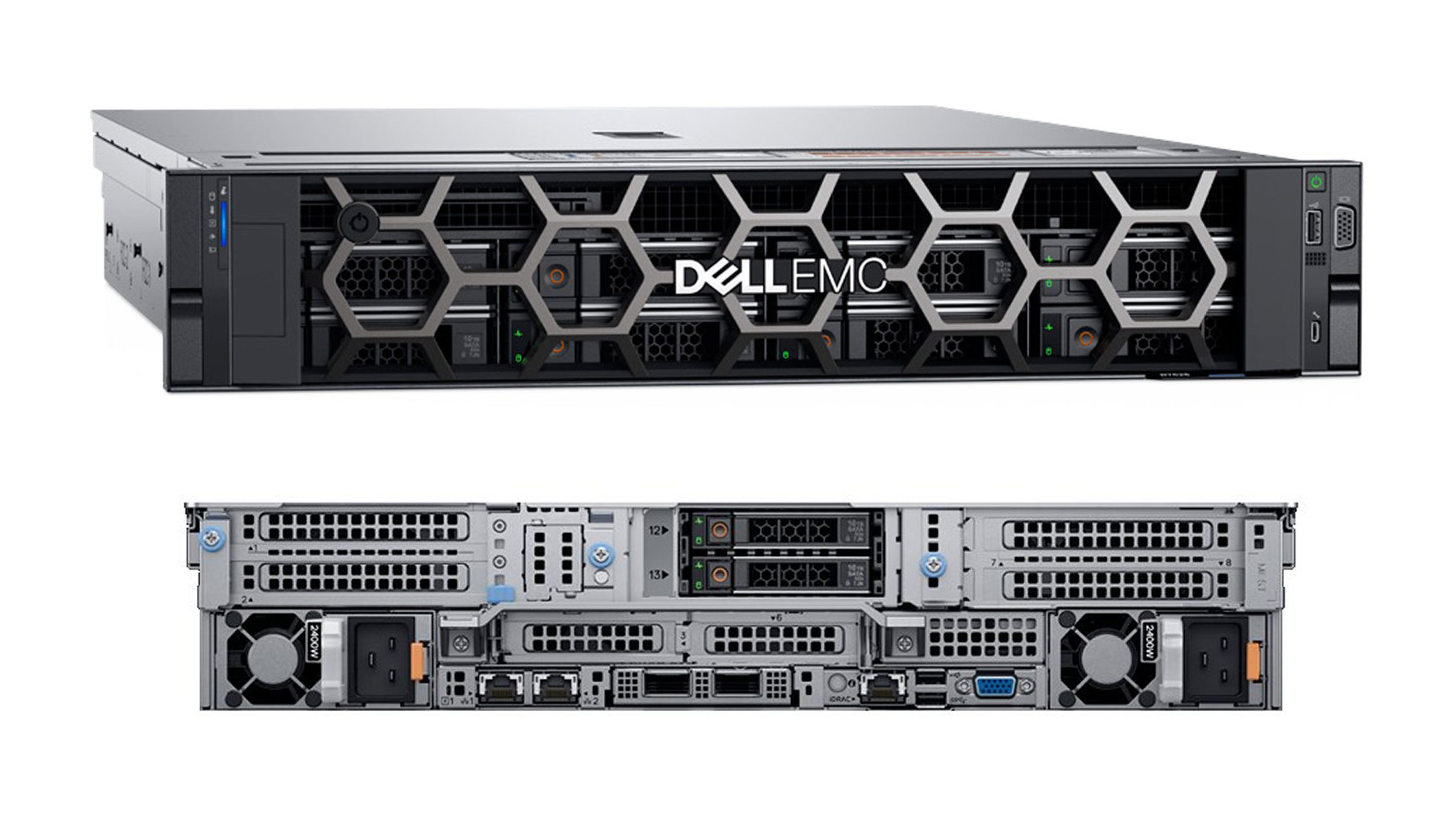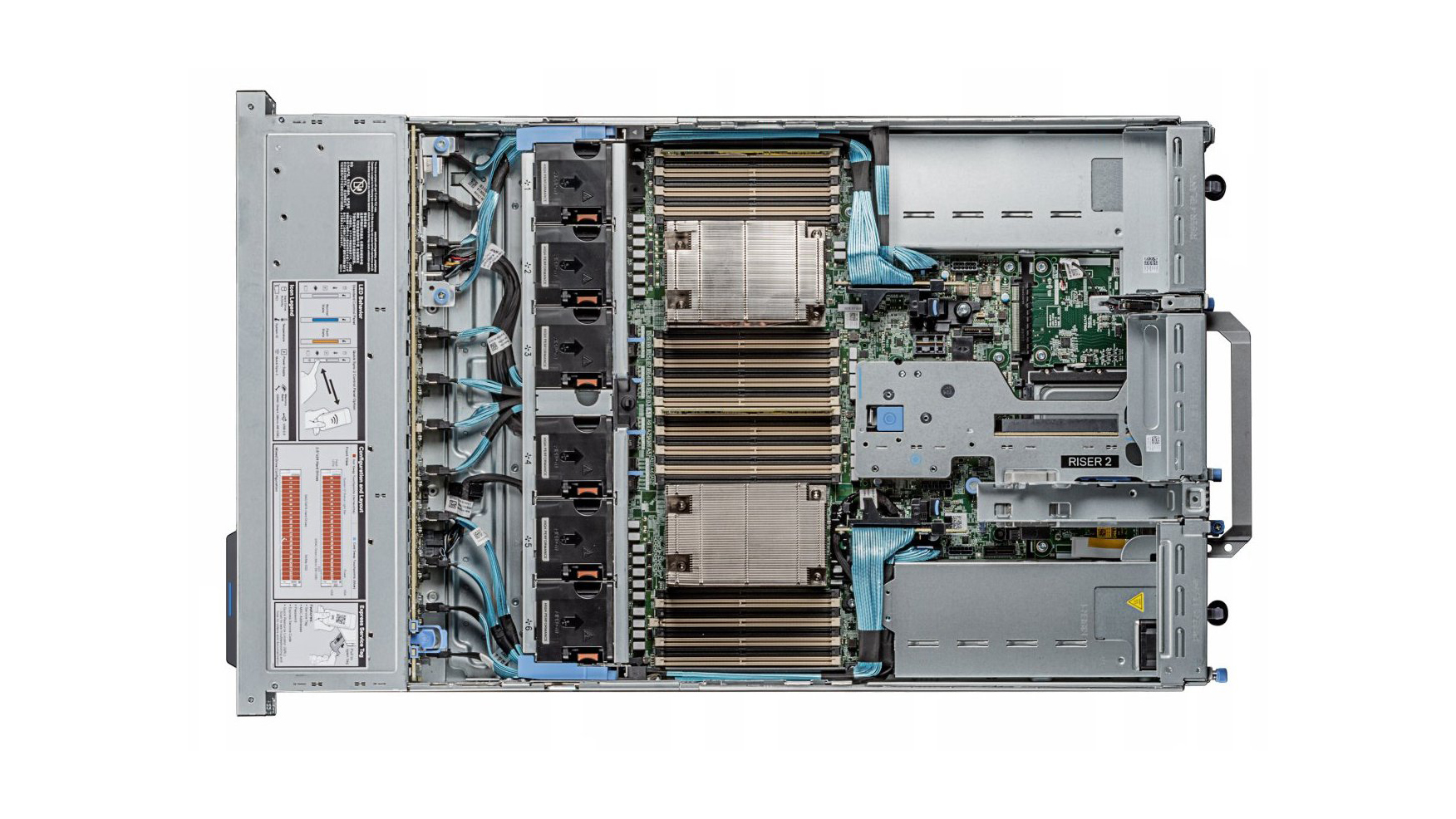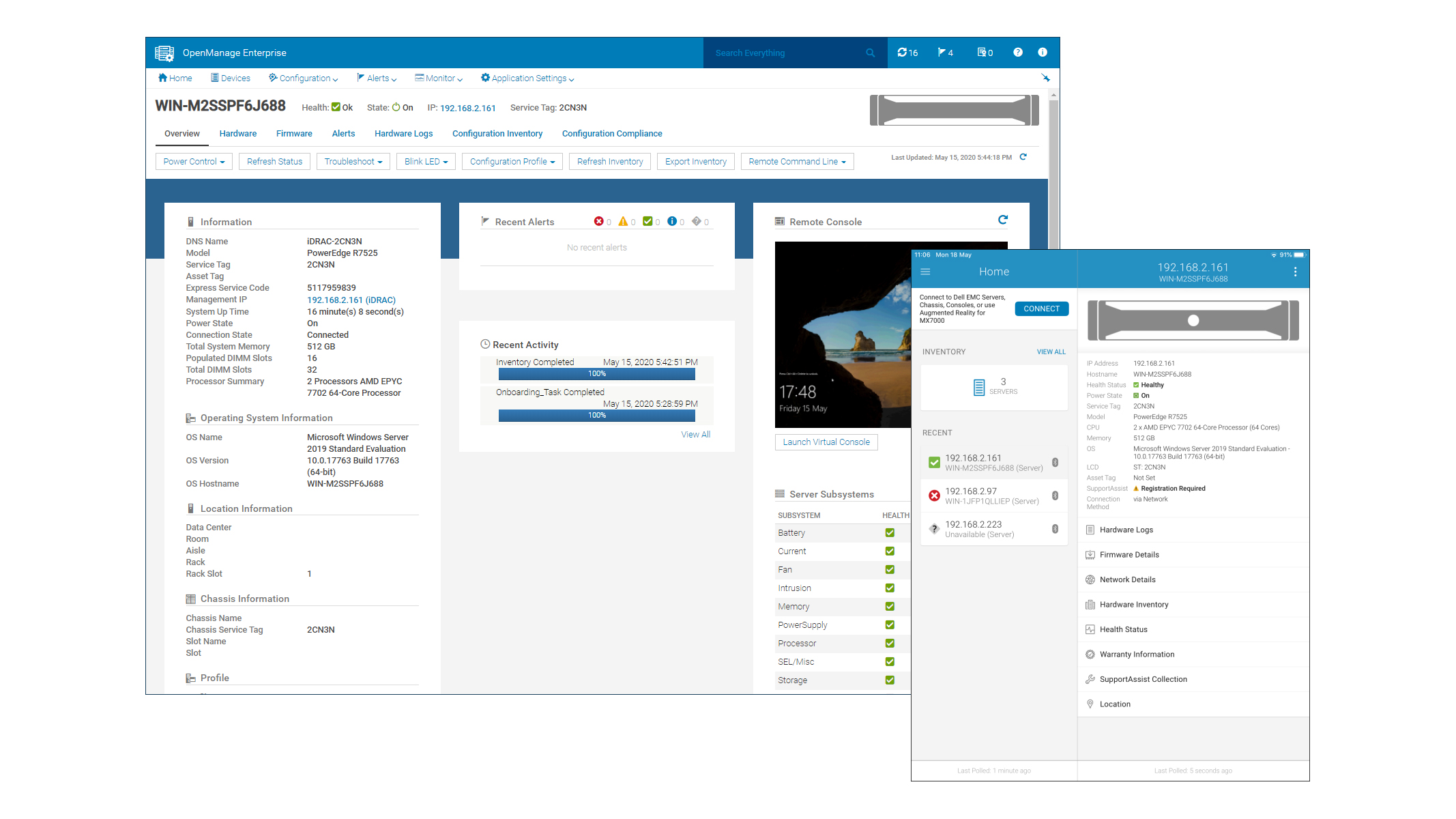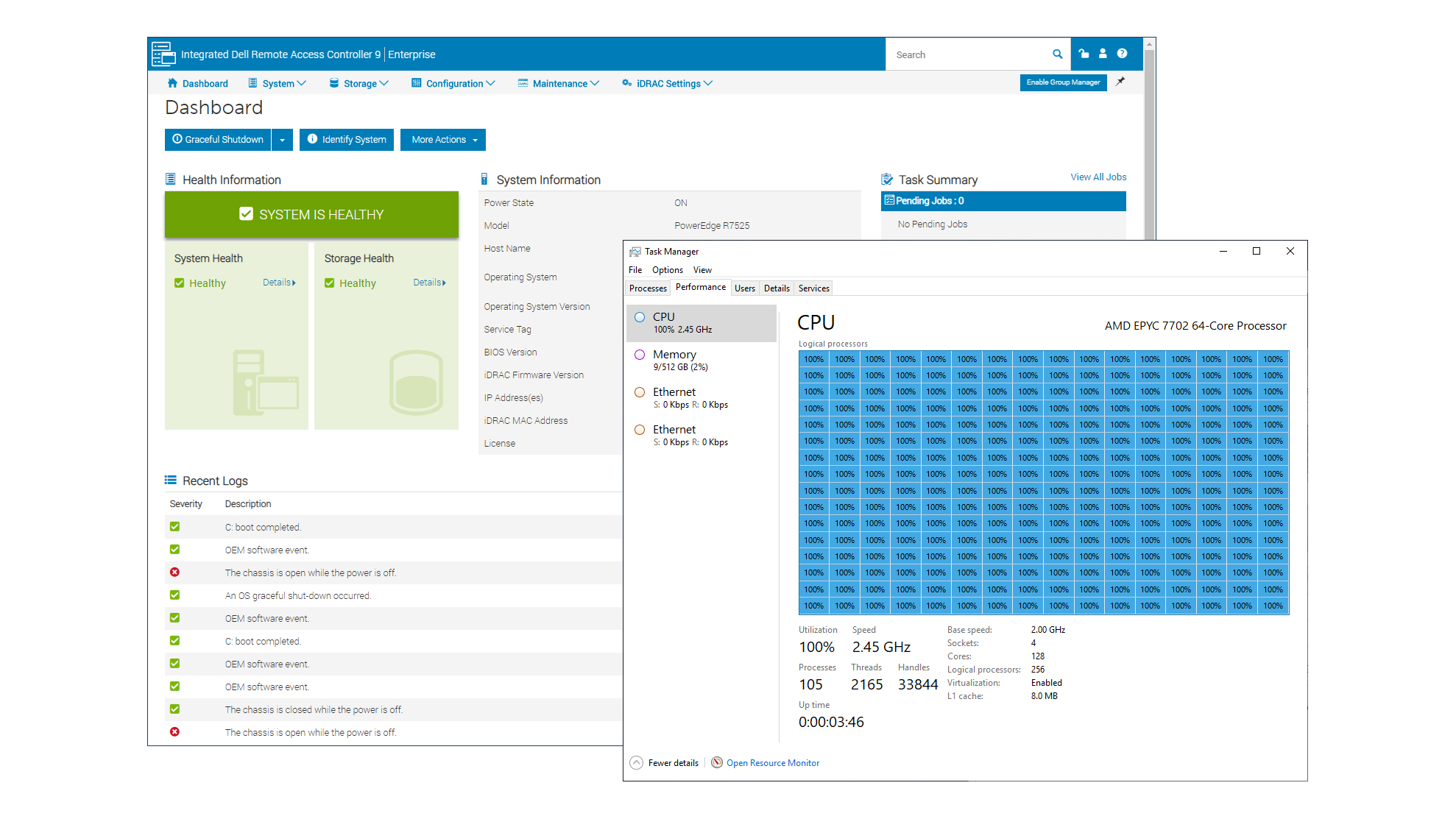Dell EMC PowerEdge R7525 review: An EPYC core density to make Intel weep
Dell delivers an object lesson in server design


-
+
Unbeatable core density
-
+
Smart new internal design
-
+
High storage and expansion potential
-
+
Future-proofed for EPYC Gen3 and PCI-E 4.0 NVMe
-
-
Power-hungry with high-TDP CPUs under load

Dell is racing ahead with its AMD EPYC server program and leaving the likes of HPE languishing in the doldrums. It now offers five PowerEdge rack models with Gen2 EPYC CPUs, and the latest R7525 on review delivers a specification that defies belief.
It supports most of AMD’s EPYC 7002 series and the system on review sports a pair of 64-core 2.0GHz EPYC 7002 CPUs - that’s a staggering 128 physical and 256 logical cores in only 2U of rack space. These AMD bad boys all offer 8 memory channels, support 3,200MHz RDIMM and 2,666MHz LRDIMM DDR4 memory and present 128 PCI-E 4.0 lanes.
The R7525 isn’t a rehash of previous generation PowerEdge servers either, and presents a completely redesigned chassis and internals. The new motherboard offers greater expansion potential, is future-proofed for the next EPYC Gen3 series and the chassis has a bigger emphasis on air cooling, so it can continue to use six standard fans even for AMD’s 280W 7H12 CPUs.
Dell EMC PowerEdge R7525 review: Design for life
Cracking the lid reveals a superbly designed interior and the first thing you’ll notice is the new T-shaped motherboard. This has allowed Dell to split the PSUs across the back of the chassis - making it more amenable to rack PDUs - and also lets the server use 2.4kW AC/HVDC modules to service the higher-power EPYCs, more expansion slots and up to 6 GPU cards.
The layout creates a more balanced air flow so there are no hot spots on one side of the server. Dell has also been able to improve PCI-E 4.0 signal integrity by rerouting some of the motherboard circuitry.

Lift off the PCI-E risers and you’ll find an OCP 3.0 mezzanine card edge slot underneath. This replaces the older proprietary LOM surface port so the R7525 can use open-standard OCP 3.0 network cards from other partners as well as Dell’s own offerings.
Storage sees a radical reshaping as Dell’s PERC RAID controllers have been moved off the motherboard and on to a dedicated slot on the storage backplane. This significantly reduces cable clutter and the new PERC H745 adapter in our system supports SAS3/SATA storage devices and all the usual enterprise RAID array suspects.
Dell EMC PowerEdge R7525 review: Storage evolution
The R7525 offers plenty of storage options, so choose your backplane carefully to save upgrading later on. Base systems start with an 8-drive LFF hot-swap backplane or you can dispense with the optical drive panel and go for a full 12-drive LFF version.
For SFF storage, you can choose from 8, 16 or 24 bays, with the hot-swap backplane incorporating a SAS expander so the RAID card can manage them all. If you’re happy to lose a PCI-Express riser, you can add an extra dual-drive SFF bay at the back.
Our review system is even more talented; it came with 16 x SSF and 8 x NVMe drive backplanes and the price we’ve shown includes six 900GB 15K SAS3 HDDs and a 375GB Intel P4800X Optane NVMe. The NVMe backplane is cabled directly to front-mounted ports on the motherboard and Dell is already qualifying PCI-E 4.0 NVMe devices – the server and backplane are ready now and will just need firmware upgrades to support them.

Last up is a full 24-bay NVMe model making the R7525 a great choice for delivering all-Flash software-defined storage (SDS). We’ve also included Dell’s BOSS (boot optimized storage solution) PCI-E card, which provides mirrored M.2 SSD storage so we could run an OS without using any front bays.
Dell EMC PowerEdge R7525 review: Expansion and power
The server’s expansion potential is impressive, with room for four dual-slot risers at the rear – another benefit of the repositioned PSUs. They’re all the PCI-E 4.0 variety and you can choose from a range of riser configurations depending on the number of x8 and x16 slots you want.
The OCP port sits underneath the two central stacked risers and our system included a Broadcom quad-port Gigabit card, with Dell also offering dual and quad-port fibre and copper 10GbE plus dual-port 10/25GbE cards. The OCP slot is flanked on one side by a standard dual Gigabit LOM card and Dell’s iDRAC9 controller on the other.
The server’s 32 DIMM slots allow the R7525 to support 2TB of 3,200MHz RDIMM and 4TB of 2,666MHz LRDIMM memory. With Windows Server 2019 loaded, we did spot the Task Manager reporting four CPU sockets but this is a known Microsoft bug that doesn’t affect performance.
As we had 200W TDP CPUs, this requires the dual 2.4kW PSUs and one drawback on these core-heavy beasts is their appetite for power. We measured the system drawing 320W with Windows Server 2019 in idle and peaking at 537W with all 128 cores under maximum load.

Dell EMC PowerEdge R7525 review: Server management
Dell’s iDRAC9 controller sets the standard for remote management, with its web console offering a wealth of information on all hardware components as well as direct access to BIOS and storage configurations. Our Enterprise X5 license brings remote console and virtual media services into play while the Datacenter X5 license enables advanced features such as streaming telemetry for predictive analytics.
You can remotely manage all your Dell systems and services from the OpenManage Enterprise (OME) software, which we run in the lab as a Hyper-V VM. Along with management and monitoring of server and storage systems, you can use it to ensure firmware compliance and keep an eye on Hyper-V and VMware hosts.
We highly recommend Dell’s Quick Sync 2 module, as it provides walk-up access directly over Bluetooth. We run the OpenManage Mobile (OMM) iOS app on our iPad and used it to monitor the R7525 and receive alert notifications on health issues.
Dell EMC PowerEdge R7525 review: Verdict
The PowerEdge R7525 is a class-leading 2U rack server that delivers a remarkable EPYC core density and an abundance of storage features. It’s perfect for enterprises looking to maximise their rack potential and the innovative new internal system design pays dividends in features, expansion and cooling.
Dell EMC PowerEdge R7525 specifications (As reviewed)
| Chassis | 2U rack |
| CPU | 2 x 64-core 2GHz AMD EPYC 7702 |
| Memory | 512GB 3,200MHz RDIMM DDR4 ECC (max 4TB with LRDIMM) |
| Storage bays | 16 x SAS/SATA SFF, 8 x NVMe (max 26 SFF) |
| RAID | Dell PERC H745 |
| Storage included | 1 x 375GB P4800X Optane NVMe, 6 x 900GB 15K SAS3 SFF |
| Other Storage | Dell BOSS with 2 x 480GB M.2 SSDs (RAID 1) |
| Network | 2 x Gigabit, 4 x Gigabit OCP 3.0 mezzanine card |
| Expansion | 8 x PCI-E 4.0 slots |
| Power | 2 x 2,400W hot-plug PSUs |
| Management | Dell iDRAC9 Enterprise X5, Quick Sync 2 module |
| Warranty | 3Yr ProSupport On-Site NBD |
Get the ITPro daily newsletter
Sign up today and you will receive a free copy of our Future Focus 2025 report - the leading guidance on AI, cybersecurity and other IT challenges as per 700+ senior executives
Dave is an IT consultant and freelance journalist specialising in hands-on reviews of computer networking products covering all market sectors from small businesses to enterprises. Founder of Binary Testing Ltd – the UK’s premier independent network testing laboratory - Dave has over 45 years of experience in the IT industry.
Dave has produced many thousands of in-depth business networking product reviews from his lab which have been reproduced globally. Writing for ITPro and its sister title, PC Pro, he covers all areas of business IT infrastructure, including servers, storage, network security, data protection, cloud, infrastructure and services.
-
 ‘Phishing kits are a force multiplier': Cheap cyber crime kits can be bought on the dark web for less than $25 – and experts warn it’s lowering the barrier of entry for amateur hackers
‘Phishing kits are a force multiplier': Cheap cyber crime kits can be bought on the dark web for less than $25 – and experts warn it’s lowering the barrier of entry for amateur hackersNews Research from NordVPN shows phishing kits are now widely available on the dark web and via messaging apps like Telegram, and are often selling for less than $25.
By Emma Woollacott Published
-
 Redis unveils new tools for developers working on AI applications
Redis unveils new tools for developers working on AI applicationsNews Redis has announced new tools aimed at making it easier for AI developers to build applications and optimize large language model (LLM) outputs.
By Ross Kelly Published
-
 Google layoffs continue with "hundreds" cut from Chrome, Android, and Pixel teams
Google layoffs continue with "hundreds" cut from Chrome, Android, and Pixel teamsNews The tech giant's efficiency drive enters a third year with devices teams the latest target
By Bobby Hellard Published